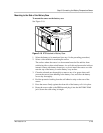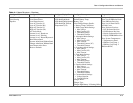
Installation
3–24 445-0089-01-01
Step 10: Connecting the Remote Shutdown
Some installations may require remote shutdown capability. This feature enables
you disable all circuitry in the PROsine and remove all power from the display
panel using a remote shutdown switch (e.g. the ignition switch in a vehicle). This
also removes all power (inverter and shorepower) from the AC loads.
The remote shutdown signal (RS+/RS–) requires a source of 5–18Vdc, which is
capable of supplying 5–18mA, to enable the PROsine. This power source must be
limited to Class 2 levels by an approved 1A fuse. The power source will often be
one of the existing system batteries: the vehicle starting battery or the PROsine
battery. In this case, the 1A fuse must be located in the positive (+) side of the
circuit, as close as possible to the power source.
Note that the remote shutdown feature will only function when the ON/OFF/REM
switch is set to REM.
Materials Required You need two high quality 26AWG, 4-conductor telephone cables with connectors
attached (one 10 feet maximum; one 100 feet maximum), one 1:2 phone line
splitter, and a 1A fuse and in-line fuseholder. In addition, you might require a
single pole, single throw switch (or alternatively, you can use a vehicle ignition-
switched circuit). You can obtain these from local hardware, electronics, and
automotive stores.
Installation Steps
See Figure 3-11 and Figure 3-12.
To connect the remote shutdown feature
1. Select one of the two cables and cut it at a convenient location for connecting
to your Remote Shutdown Switch.
2. See Figure 3-11 to identify the RS+ and RS– wires.
3. Insulate the two middle wires so they don’t short.
4. Connect RS+ to the positive of a switched, fused voltage source of 5–18V.
5. Connect the RS– to the return of this voltage source.
6. Plug the cables into the splitter and connect to the PROsine as shown in
Figure 3-11.
The Remote Shutdown feature is now ready for use. For operating information,
see “ON/OFF/REMote Control of PROsine Operation” on page 5–3.
WARNING: Shock hazard
This step should only be completed by qualified installers or technicians who have a
knowledge of DC circuits.
Connect only to an isolated Class 2 extra-low voltage power source as described below.


















